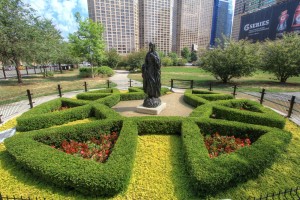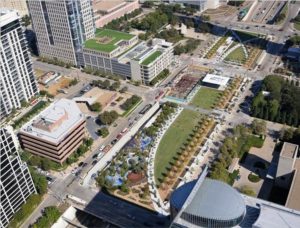Public open space and facilities for sport, recreation, and passive natural areas directly support the quality of life in the West Loop. They are an important element and driver to the community’s health and wellness. When new development occurs it is important that sufficient open space in each of the above categories are created to meet the needs arising from the new development; to ensure that opportunities for play, relaxation and enjoyment are provided as well as providing green spaces for nature and even to allow new developments to “breathe”.
Open space is an important element of sustainable development and can motivate people to walk and cycle as well as providing connections for building community and to other areas. It is important that open space be included within an overall master/strategic plan and not seen as last minutes add-ons.
The West Loop has different types of green space and open space with varying degrees of public access: publicly owned Chicago Park District Parks (Skinner and the Skinner Dog Friendly Area, Fulton River Park, Heritage Green Park, Mary Bartelme Park, Union Park) and other open space like Chicago Public School owned green space.
Despite the variety and number of green spaces, the West Loop is significantly under-served by public open space based on minimum standards set by the City of Chicago (2 acres / 1,000 residents) and national standards (10 acres/1,000 residents). Currently, there is only 12.2 acres of public open space in the West Loop. Using 2010 census statistics, the West Loop is short 30+ acres in open space (75% deficit). Union Park is not considered to be in the West Loop by the City of Chicago but residents considered it within the West Loop neighborhood due to its proximity. Even with the annexation of Union Park, the West Loop is still short more than 20 acres of open space based on the 2010 population (see Appendix D, Section 2 – Open Space Analysis).
In addition, developers and City of Chicago need to address the need for dog parks in a more comprehensive way. There is a general misconception that DFAs are places for dogs to relieve themselves. Small dog runs in developments and small parks do not meet the needs of this significant segment of the community who are dog owners. Poorly designed and sized facilities lead to conflicts within the whole community especially considering the green/open space deficit.
The following is a summary of recommendations for improvements to parks and green space. Recommendations are broken out by strategic vision and goals to address the critical open space deficit that grows with each new development and more immediate short term goals to address current improvements needed for existing green space:
5.1 Develop a strategic plan to address the West Loop’s green space deficit.
a. Develop a holistic strategic plan to address the deficit of public green/open space in the West Loop especially in the subareas of Fulton Market, West Loop Gate, and Fulton River.
b. First proposed in the 2003 Central Area Action Plan, CAP the Kennedy should be made a priority. This is an elegant solution to address the open space deficit in a substantial and meaningful way. Public funding sources and private donations (including by developers that will benefit financially from the project) should be gathered to make the project a reality.
c. Increase the open space impact fees structure for the West Loop; the current fee structure is insufficient to meet the open space needs of the West Loop especially given the skyrocketing cost of land acquisition.
d. Reprioritize the use of CPS facilities, e.g., green space, gymnasiums, pools, for public access vs. private programs.
e. New development projects should include ground-level public green space, e.g., pocket parks at corners – especially larger projects (see 1.11 above). The minimum size to these pocket parks should be 3,500 sq ft and should increase proportionally relative to the size of the building/development.
f. Expand existing parks, acquiring land where necessary.
5.2 Ensure that parks, park facilities, and green spaces meet the needs of ALL residents.
a. Better manage use of existing parks to ensure all residents have quality access.
b. Coordination should take place to limit permit types issued for each park so the community has access during quality times.
c. Concert promoters, City officials, the Park District, and residents should continue to coordinate ahead of major concerts/festivals at Union Park to minimize adverse impacts on residents.
d. Parks should be monitored to curb illegal usage, e.g., unauthorized parties and gatherings.
e. Develop a plan to help address the conflicts between some dog owners and other park users over the sharing of the green space at Bartelme and Fulton River Parks.
f. Redesign existing parks with improved facilities to better meet community needs.
5.3 Provide more dog friendly areas (DFAs).
a. Build quality and larger dog friendly areas that are designed to meet the needs of dog owners to resolve some of the conflicts of sharing common green space and parks in the West Loop.
b. Developers should fund the development & upkeep of large public DFAs near their projects that will benefit the residents and users of their properties as well as the larger community, including progressive companies in the neighborhood that allow employees to bring dogs to work.
c. DFAs should have small & large dog areas.
5.4 Park-specific recommendations: Union Park (27th Ward)
a. As identified in the Near West Plan, pedestrian access to Union Park should be improved, in particular from the east.
b. The Union Park outdoor swimming pool should be improved and better promoted to attract more residential use.
c. Recommendations for ongoing improvement from the Union Park Advisory Council should be taken into consideration to better activate Union Park in the future.
d. Ensure that more music festival revenue is retained for improvements at Union Park.
5.5 Park-specific recommendations: Skinner Park (27th Ward)
a. Build a new fieldhouse with an indoor community pool to replace the 1950s era fieldhouse at Skinner Park is outdated and undersized to serve the community.
b. Expand Skinner Park’s green space to meet the green/open space needs of the growing residential community as well as the 4,000+ students from nearby public and private schools who rely on Skinner Park for recreational and sports fields.
c. Retain usage of the Whitney Young High School pool and gym by the Chicago Park District for lifeguard training & testing, city wide programs and events like swim meets, and additional programs.
d. Expand the vegetable community garden in Skinner Park which has a long waiting list.e. Develop a public DFA for small dogs to complement the current DFA near Skinner Park. Opportunities exist with new developments near Skinner Park especially in the 28th Ward.
5. 6 Park-specific recommendations: Fulton River Park & Heritage Green Park (42nd Ward)
a. Park advisory councils should be developed for Heritage Green and Fulton River Parks to advocate and identify needs for programs and events, maintenance and repairs, and capital improvement projects to better serve nearby residents.
b. Develop a plan/redesign of the parks to balance the sharing of park space to resolve current conflicts with some dog owners and to better serve all park users, e.g., a dog friendly area (DFA) at Heritage Green Park, redesigning Fulton River Park to better serve the community.
c. Create community gardens in Heritage Green Park and Fulton River Parks.


